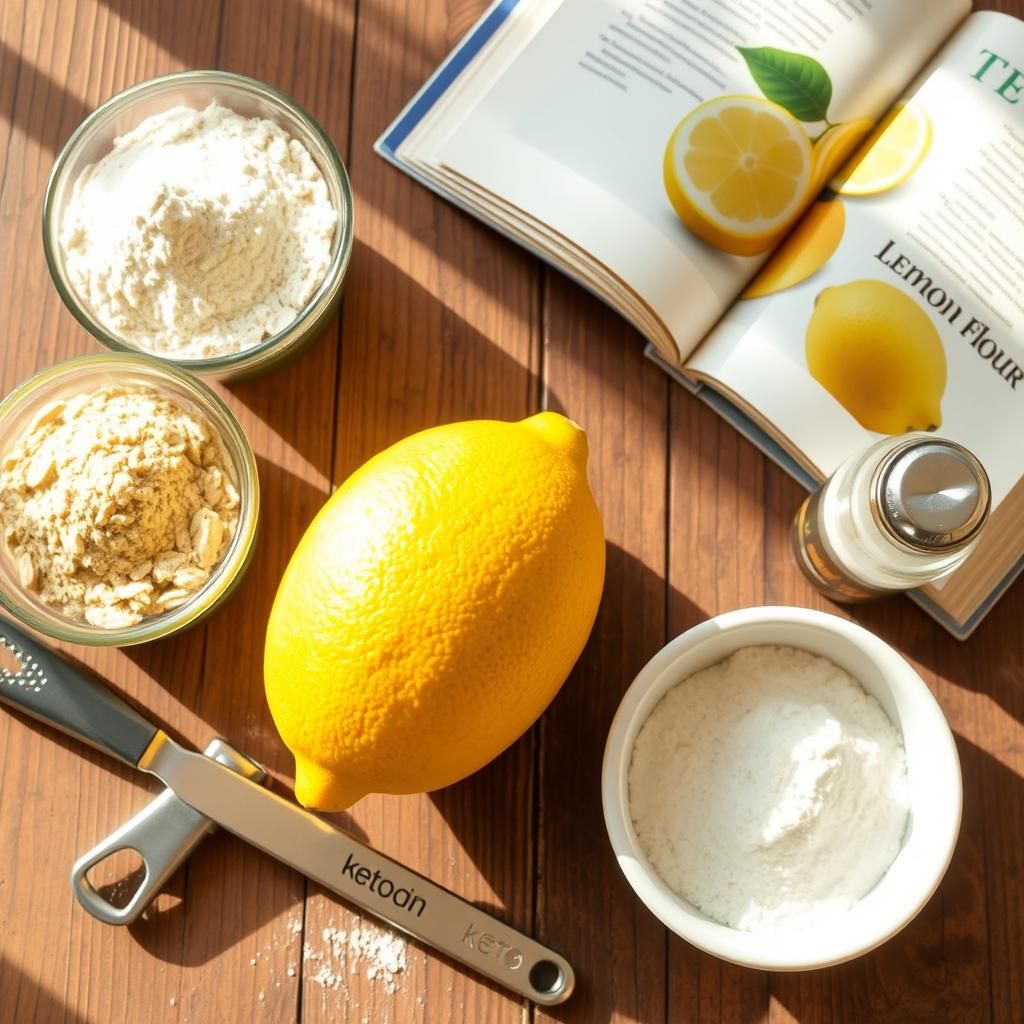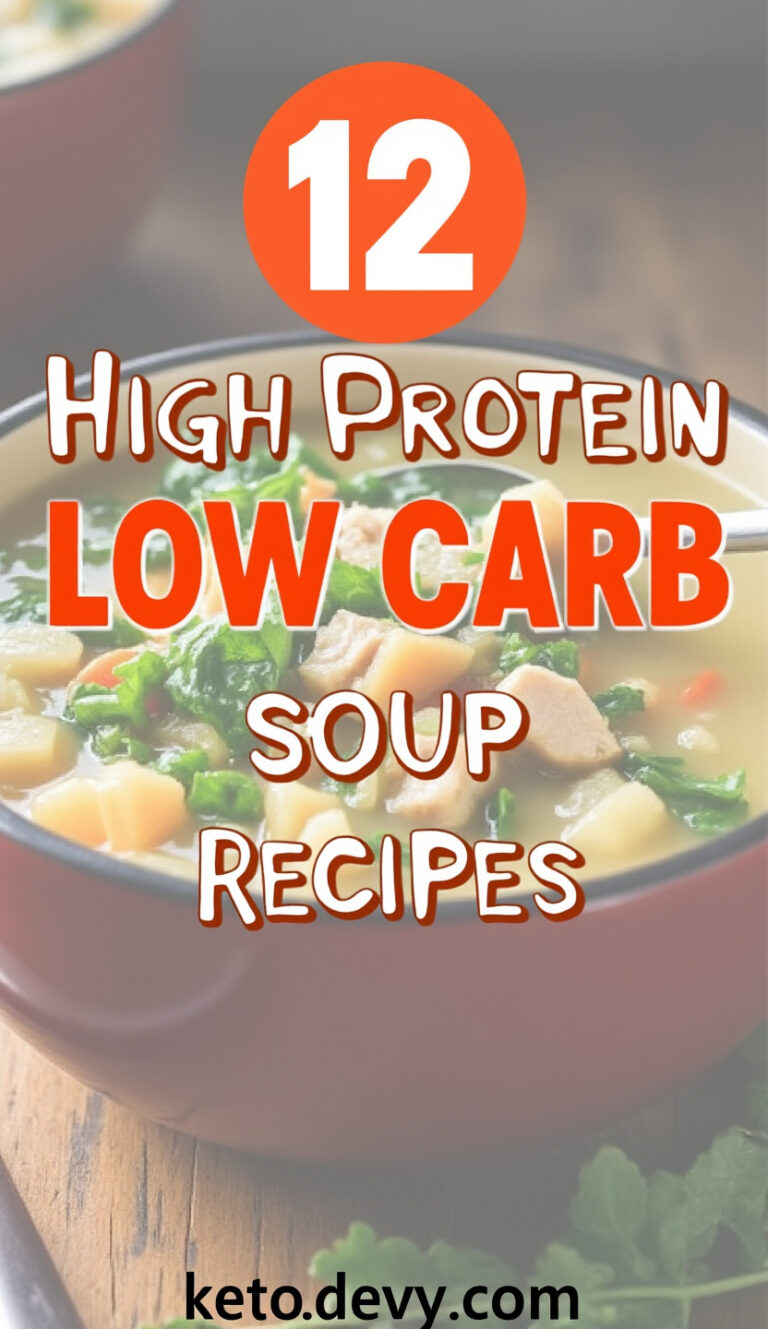Keto Lemon Bread – NO Coconut Flour Needed!
Craving a slice of sunshine but sticking to your keto lifestyle? You’re not alone. One of the biggest challenges on a low-carb journey is navigating the world of baked goods. Traditional bread, cakes, and muffins are loaded with sugar and high-carb flour, making them off-limits. However, the desire for a comforting, flavorful treat doesn’t disappear just because you’re avoiding carbs.
Lemon bread is a classic comfort food, bright and zesty, perfect for breakfast, a snack, or dessert. But most recipes rely heavily on wheat flour and sugar. The keto community has embraced alternatives, often turning to ingredients like almond flour and coconut flour. While coconut flour is a staple for many, it presents unique challenges for some – be it due to allergies, sensitivities, or simply a dislike for its texture or distinct taste.
This is where our recipe comes in. We’ve cracked the code on creating a genuinely delicious, moist, and tender Keto Lemon Bread that completely bypasses coconut flour. Instead, we harness the power of readily available almond flour and other keto-friendly ingredients to deliver a loaf that satisfies those sweet and citrusy cravings without kicking you out of ketosis. This recipe is designed for ease, maximum flavor, and that perfect crumb texture you thought wasn’t possible in keto baking without coconut flour.
Whether you’re a seasoned keto baker or just starting, this guide provides everything you need: a tested recipe, detailed explanations of *why* it works, expert tips, troubleshooting advice, and variations to keep things exciting. Get ready to bake a loaf that will become your new favorite keto treat.
Why “No Coconut Flour”? Understanding the Alternative
Coconut flour is a popular ingredient in keto and gluten-free baking due to its high fiber content and absorbency. However, these very properties can make it tricky to work with. Coconut flour is incredibly thirsty, soaking up a lot of liquid. This means recipes require significantly more eggs and wet ingredients, and if not formulated perfectly, the resulting bake can turn out dry, dense, or with an off-putting crumbly texture.
Furthermore, coconut flour has a distinct flavor that some people find overpowering or simply don’t enjoy. For those with coconut allergies or sensitivities, it’s entirely off the table. This leads many keto bakers to seek alternatives that provide a better texture and a more neutral flavor profile.
This recipe focuses on almond flour. Almond flour is made from ground almonds and is far less absorbent than coconut flour. It provides a tender, moist crumb that is much closer to traditional baked goods made with wheat flour. It has a mild, slightly nutty flavor that pairs beautifully with lemon.
Using almond flour allows for a more forgiving recipe with a more predictable outcome. When combined with other keto-friendly binding agents like eggs and potentially a tiny bit of xanthan gum, it creates a stable structure that results in a moist, fluffy (for keto standards!) loaf that holds together without the density or dryness often associated with coconut flour bakes. We delve into the specific properties of almond flour and other ingredients in later sections to help you understand the science behind this delicious, coconut-free success.
Keto Baking Fundamentals: Building Blocks for Success
Successfully navigating keto baking requires understanding how different ingredients behave compared to their high-carb counterparts. Since we avoid traditional sugar and wheat flour, we need to rely on alternative flours, non-glycemic sweeteners, and fats to create structure, flavor, and moisture.
Here are the fundamental principles at play in this recipe:
1. Low-Carb Flours: Instead of wheat flour, which is high in carbs and gluten, we use almond flour. Almond flour provides bulk, structure, and a tender crumb. Unlike wheat flour, it contains fat and protein but lacks gluten, the protein network that gives traditional bread its elasticity and chew. This is why keto baked goods often require alternative binders. You can explore different 500 Delicious Keto Recipes Cookbook for various baking approaches.
2. Keto Sweeteners: Traditional sugar is replaced with sweeteners that have little to no impact on blood sugar levels. Common options include Erythritol, Monk Fruit Extract, Stevia, Allulose, and Xylitol (caution: Xylitol is toxic to dogs). These provide sweetness but don’t feed yeast (not relevant for quick bread, but good to know for yeasted keto breads) and can sometimes interact differently with other ingredients compared to sugar. Using powdered or granulated blends often works best in baking. Satisfy your sweet tooth with low-carb options found in a Keto Dessert Book.
3. Fats: Fats are crucial in keto baking, providing moisture, richness, and helping to carry flavor. Butter, coconut oil, and avocado oil are common choices. Since low-carb flours like almond flour contain fat, this also contributes to the overall richness and tenderness of the bake.
4. Eggs: Eggs play a vital role as a binder, leavening agent, and source of moisture and structure. Without gluten, eggs are essential for holding the baked goods together and preventing them from becoming too crumbly. Using room-temperature eggs can also help with emulsion and volume.
5. Leavening Agents: Baking powder and baking soda (used in conjunction with an acid like lemon juice or sour cream) create air pockets, helping the bread to rise and become lighter. It’s important to ensure your leavening agents are fresh for the best results.
6. Binders (Optional but Recommended): Because low-carb flours lack gluten, sometimes an additional binder is needed to prevent crumbling, especially in loaves. Xanthan gum is a common additive used in tiny amounts to mimic the elastic properties of gluten and improve the texture and structure of the final product.
Understanding these principles helps you anticipate how the ingredients will interact and troubleshoot potential issues. This recipe is formulated to leverage these principles effectively, ensuring a delicious and stable loaf without relying on coconut flour. For a broader understanding of keto ingredients and cooking methods, check out resources like The Keto Diet or a Keto Air Fryer Cookbook.
The Star Ingredients: What Makes This Lemon Bread Keto and Coconut-Free?
Let’s take a closer look at the specific ingredients used in this recipe and why they are chosen for a delicious, moist, and coconut-flour-free keto lemon bread.
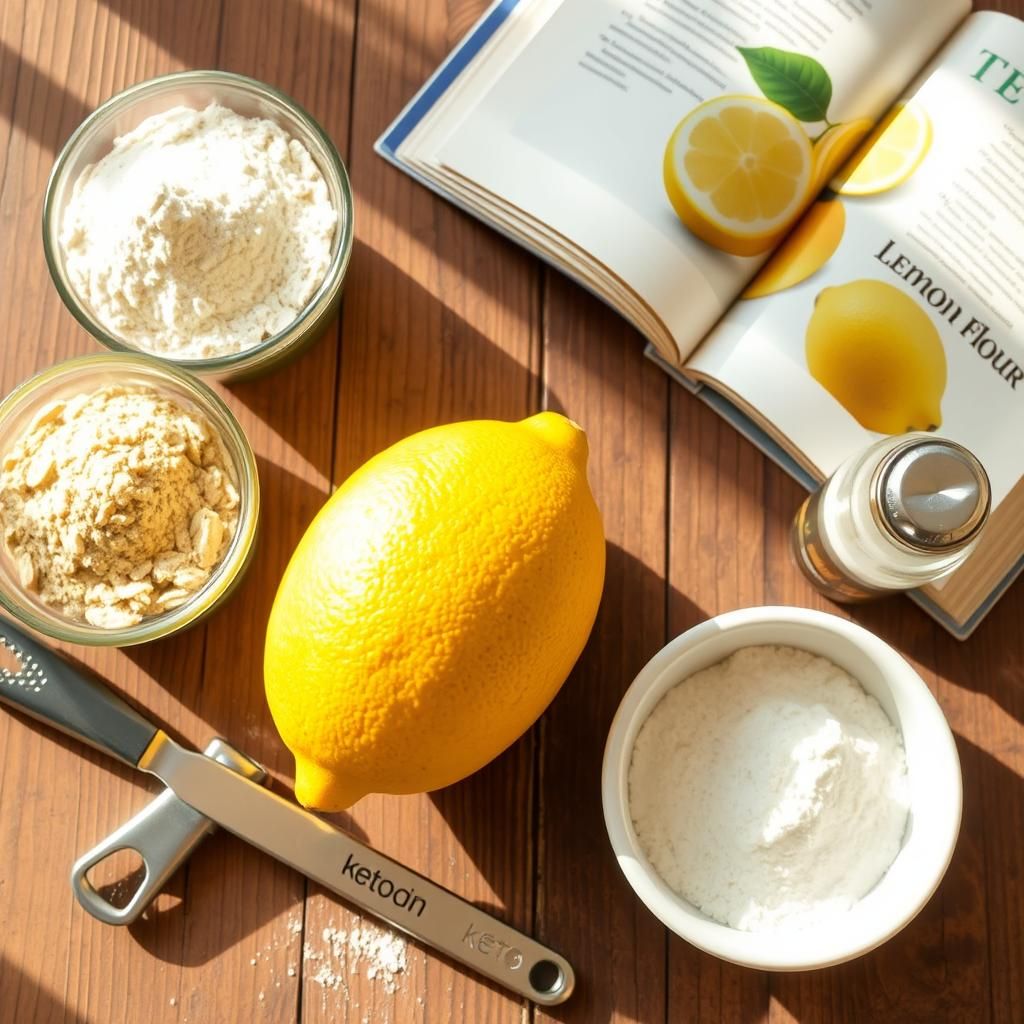
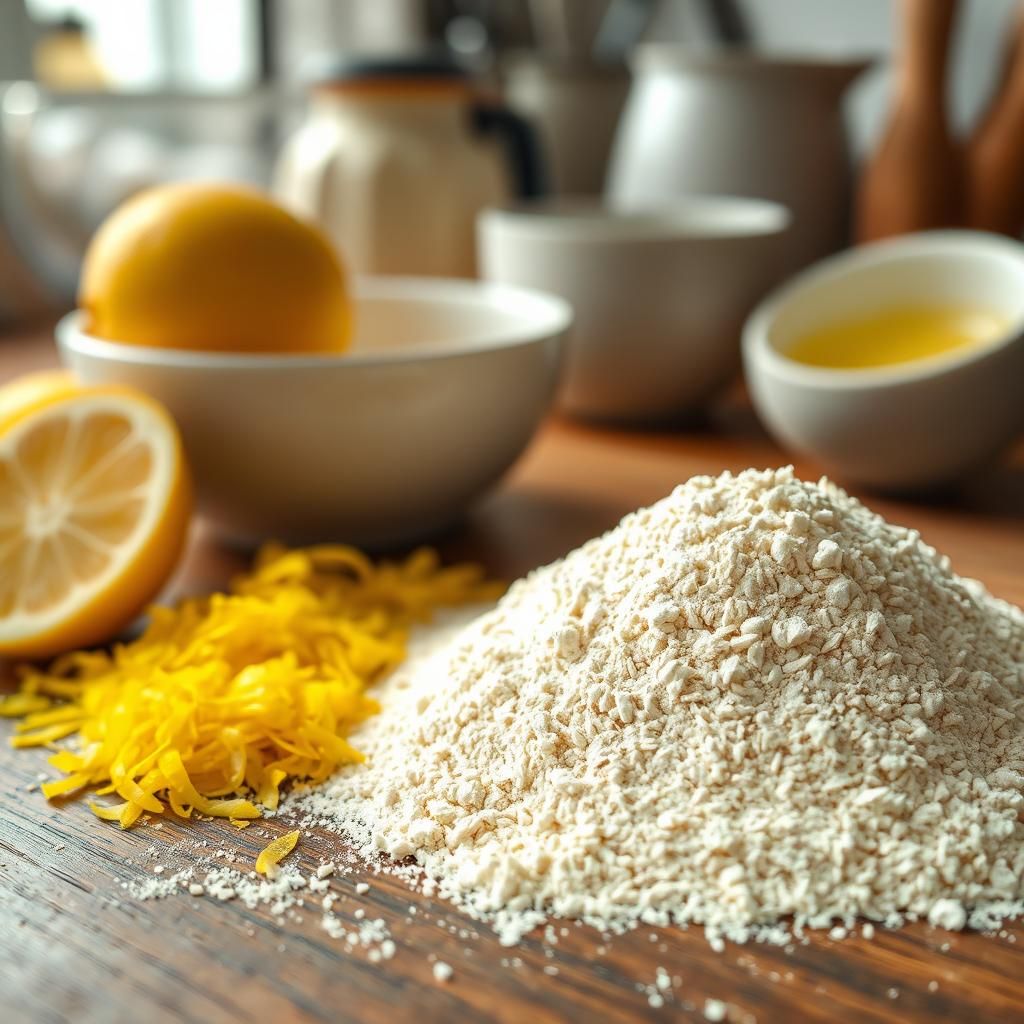
- Almond Flour: As discussed, this is our primary flour. Use *finely ground* almond flour (sometimes called almond meal if it’s coarser, but for baking, “flour” is preferred). It should look like a fine powder, not chunky. This provides the bulk of the structure and creates a tender crumb. Its higher fat content also contributes to moisture. Make sure it’s fresh; old almond flour can develop an off taste.
- Keto Sweetener: A granulated or powdered keto sweetener blend is best. Erythritol, monk fruit blends, or allulose are good choices. Granulated works fine, but powdered (or pulsing granulated in a blender/food processor) can lead to a smoother texture with less chance of grittiness. Choose a blend that measures cup-for-cup with sugar for easiest conversion. Note: Some sweeteners like erythritol can have a cooling effect; blends often minimize this.
- Large Eggs: Provide binding, structure, richness, and help with leavening. Ensure they are at room temperature for better incorporation into the batter, leading to a more even rise and texture.
- Butter (Melted & Cooled) or Oil: Melted butter provides classic richness and flavor. Unsalted butter gives you control over the salt level. Alternatively, you can use a neutral-flavored oil like avocado oil or a light olive oil for a dairy-free option. Coconut oil (refined, if you want no coconut flavor) is also an option here as a fat source, even though we avoid coconut flour. Using melted fat contributes to a moist crumb.
- Full-Fat Sour Cream or Greek Yogurt: This is a secret weapon for moist and tender baked goods in keto. The fat and acidity help create a softer texture and add moisture without adding significant carbs. Full-fat versions are key for keto macros and richness. If dairy-free, a full-fat dairy-free sour cream or coconut cream (from a can, only the thick top part) could potentially work, though the texture might differ slightly.
- Lemon Zest: Where the *real* lemon flavor comes from! The oils in the zest are potent and fragrant. Use a microplane zester to get only the yellow part, avoiding the bitter white pith. Don’t skimp on the zest; it’s essential for that bright, fresh lemon taste.
- Fresh Lemon Juice: Adds tartness, complements the zest, and provides liquid and acidity needed for the baking powder to activate. Fresh juice is always best for flavor.
- Vanilla Extract: A classic flavor enhancer that complements both the lemon and the sweetness.
- Baking Powder: Our main leavening agent. Reacts with the liquid and acid (lemon juice, sour cream) to create carbon dioxide bubbles, making the bread rise. Ensure it’s fresh by checking the expiration date.
- Xanthan Gum (Recommended): While not strictly *required*, a small amount of xanthan gum dramatically improves the texture of keto baked goods made without gluten or coconut flour. It acts as a binder, preventing the loaf from being too crumbly and giving it a better structure. Use sparingly; too much can result in a gummy texture.
- Salt: Essential for balancing the sweetness and enhancing all the other flavors. Don’t skip it!
By carefully selecting and combining these ingredients, we achieve a moist, flavorful, and structurally sound lemon bread that is completely free from coconut flour and perfectly suited for a ketogenic diet. The specific ratios are key, which is why following the recipe carefully is important. For more ideas on low-carb baking, check out a Keto Breads and Pizza recipe book.
Expert Tips for Perfect Keto Lemon Bread Every Time
Even with the right ingredients, baking can be finicky. Keto baking introduces its own set of nuances. Here are expert tips to help ensure your coconut-flour-free keto lemon bread turns out perfectly on your first try and every time after:
1. Accurate Ingredient Measurement is Crucial
- Almond Flour: Do NOT scoop almond flour directly from the bag with your measuring cup. Spoon the flour lightly into the measuring cup and then level it off with a straight edge (like the back of a knife). Scooping can compact the flour, leading to too much flour and a dry, dense bread. Weighing is even more accurate if you have a kitchen scale.
- Sweeteners: Ensure you’re using a keto sweetener blend that is a 1:1 replacement for sugar by volume if the recipe specifies cups. If using pure erythritol or monk fruit extract, you’ll need to adjust the amount based on its sweetness intensity relative to sugar. Powdered sweeteners generally incorporate better.
- Xanthan Gum: Measure this precisely. Too much will make your bread gummy. It’s a potent binder, and a little goes a long way.
2. Ingredient Temperature Matters
- Ensure your eggs and any dairy (like sour cream or Greek yogurt) are at room temperature. This helps them emulsify better with the fats and other ingredients, creating a smoother batter and a more consistent texture in the final bake. Set them out on the counter about 30-60 minutes before you start mixing.
- Melted butter should be slightly cooled, not hot, before adding it to the batter, especially when combined with eggs. Hot butter could start to cook the eggs.
3. Don’t Overmix the Batter
Keto batters are different from wheat batters. There’s no gluten development to worry about. Once the dry ingredients are just incorporated into the wet ingredients, stop mixing. Overmixing can introduce too much air initially, which might cause the bread to rise too quickly and then sink, or result in a tougher texture (though less likely with almond flour than wheat). Mix until just combined.
4. Maximize Lemon Flavor
- Zest First: Always zest your lemons *before* juicing them. It’s much easier to zest a firm, whole lemon. Use a microplane zester for fine zest that distributes evenly and releases maximum flavor oils.
- Roll the Lemon: Before juicing, roll the whole lemon firmly on the counter under your palm. This helps break down the membranes inside and makes it easier to extract more juice.
- Fresh is Best: Use fresh lemons, not bottled lemon juice, for the brightest, most authentic flavor.
5. Choose the Right Sweetener
Different keto sweeteners behave differently. Some can crystalize upon cooling (like pure erythritol), while others absorb moisture (like Allulose). Blends often mitigate these issues. Consider using a powdered sweetener for a smoother glaze. If you use a liquid sweetener, you may need to adjust the amount of other liquids in the recipe.
6. Use Parchment Paper
Lining your loaf pan with parchment paper (with some overhang on the sides) makes removing the finished bread incredibly easy and prevents sticking. Keto breads can sometimes be more delicate than traditional ones, so this is a helpful step.
7. Test for Doneness Correctly
Keto baked goods might not dome as high as traditional ones. The best way to test for doneness is the toothpick test. Insert a toothpick or cake tester into the center of the loaf. It should come out clean or with a few moist crumbs attached, but no wet batter. If it comes out wet, continue baking for a few more minutes and test again.
8. Cool Properly
Allow the bread to cool in the pan for about 10-15 minutes before attempting to lift it out using the parchment paper overhang. Then, transfer it to a wire rack to cool completely. Slicing too early can result in a gummy texture or cause the loaf to fall apart, as keto breads continue to set as they cool. Ensure it’s fully cooled before glazing or storing.
9. Know Your Oven
Oven temperatures can vary. Using an oven thermometer can help ensure your oven is heating to the correct temperature. If your bread is browning too quickly on top but not cooked through, you can loosely tent it with aluminum foil during the last part of the baking time.
Implementing these tips will significantly improve your keto baking results and help you achieve a perfectly moist and delicious loaf of coconut-flour-free lemon bread. For comprehensive guidance on maintaining a keto lifestyle, consider a Custom Keto Diet plan.
Step-by-Step Recipe Instructions
Ready to bake? Here is the detailed recipe for our Keto Lemon Bread – NO Coconut Flour Needed!

Yields: 1 loaf (approx. 10-12 slices)
Prep time: 15 minutes
Bake time: 45-60 minutes
Cooling time: Approx. 1 hour+
Equipment:
- Large mixing bowl
- Medium mixing bowl
- Whisk
- Rubber spatula or wooden spoon
- Measuring cups and spoons
- Microplane zester
- Citrus juicer
- 9×5 inch loaf pan
- Parchment paper
- Wire cooling rack
Ingredients:
- 2 cups (224g) Finely Ground Almond Flour
- 1/2 cup (96g) Granulated or Powdered Keto Sweetener (use a 1:1 sugar replacement blend)
- 2 tsp Baking Powder (ensure it’s fresh)
- 1/2 tsp Xanthan Gum (optional, but highly recommended for texture)
- 1/4 tsp Salt
- 1/2 cup (113g) Unsalted Butter, melted and slightly cooled (or equivalent neutral oil)
- 3 Large Eggs, at room temperature
- 1/2 cup (120g) Full-Fat Sour Cream or Greek Yogurt
- Zest of 2-3 large lemons (about 1 1/2 to 2 tbsp)
- 1/4 cup (60ml) Fresh Lemon Juice
- 1 tsp Vanilla Extract
Optional Keto Lemon Glaze Ingredients:
- 1/2 cup (60g) Powdered Keto Sweetener (like erythritol or monk fruit blend)
- 1-2 tbsp Fresh Lemon Juice (or heavy cream/almond milk for a less tart glaze)
Instructions:
1. Preheat and Prepare: Preheat your oven to 350°F (175°C). Grease a 9×5 inch loaf pan and line it with parchment paper, leaving an overhang on the long sides for easy removal.
2. Combine Dry Ingredients: In a large mixing bowl, whisk together the almond flour, keto sweetener, baking powder, xanthan gum (if using), and salt. Whisk well to combine and break up any clumps. Ensure the baking powder and xanthan gum are evenly distributed.
3. Combine Wet Ingredients: In a separate medium mixing bowl, whisk together the slightly cooled melted butter (or oil), room temperature eggs, sour cream (or Greek yogurt), lemon zest, fresh lemon juice, and vanilla extract until well combined and smooth.
4. Combine Wet and Dry: Pour the wet ingredients into the bowl with the dry ingredients.
5. Mix Batter: Use a rubber spatula or wooden spoon to gently mix the ingredients together. Mix until *just* combined and no dry streaks of flour remain. Do not overmix. The batter will be thick.
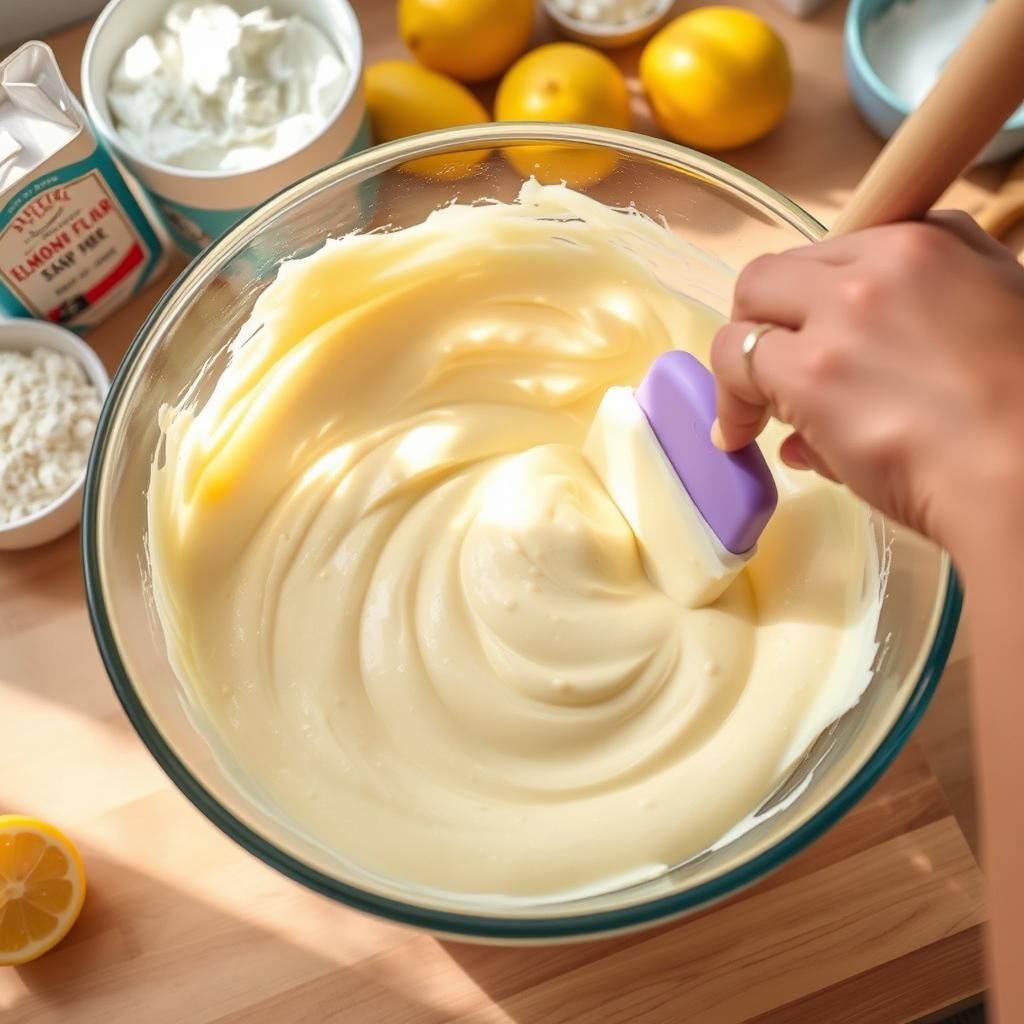
6. Pour into Pan: Scrape the batter into the prepared loaf pan. Smooth the top evenly with the spatula.
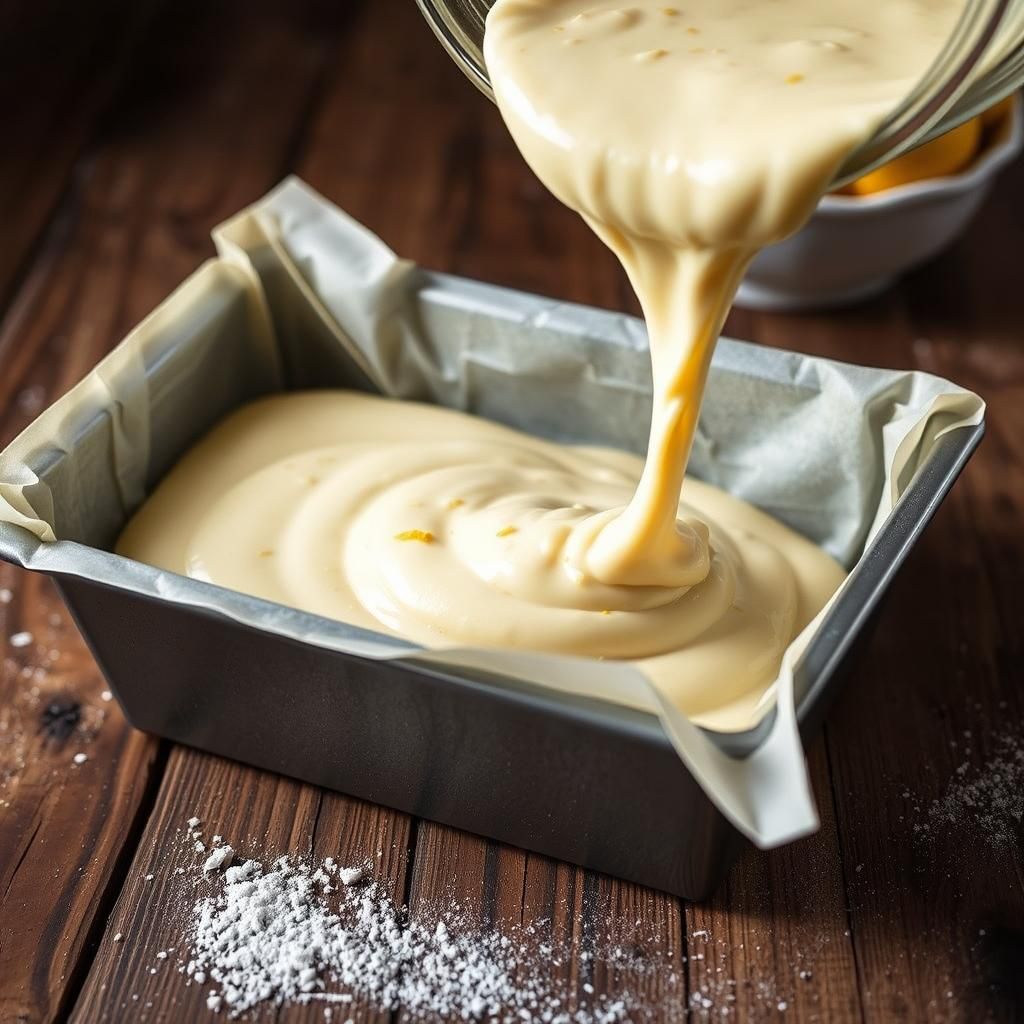
7. Bake: Place the loaf pan in the preheated oven. Bake for 45-60 minutes. The exact time will vary depending on your oven. Start checking around 45 minutes.
8. Check for Doneness: The bread is done when the top is golden brown, the edges pull away slightly from the sides, and a toothpick inserted into the center comes out clean or with only a few moist crumbs attached (no wet batter). If the top is browning too fast, you can loosely tent the loaf with aluminum foil.
9. Cool: Remove the loaf from the oven and place the pan on a wire cooling rack. Let the bread cool in the pan for at least 10-15 minutes.

10. Remove from Pan: Use the parchment paper overhang to carefully lift the bread out of the pan and transfer it completely onto the wire cooling rack.
11. Cool Completely: Let the bread cool *completely* on the wire rack before slicing or glazing. This is crucial for texture. It can take 1-2 hours or more.
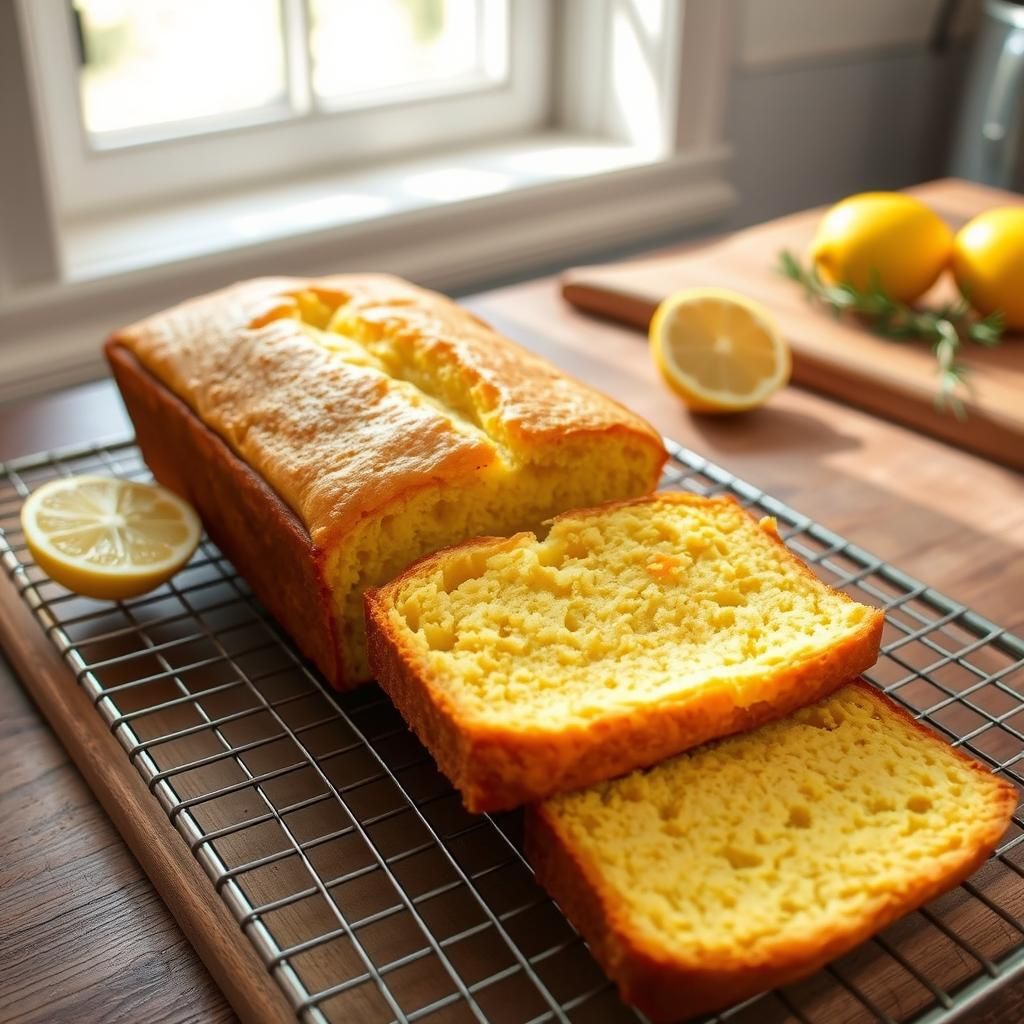
12. Prepare Glaze (Optional): If adding a glaze, whisk together the powdered keto sweetener and 1 tablespoon of lemon juice (or liquid of choice) in a small bowl. Add the second tablespoon of lemon juice only if needed to reach your desired pourable consistency.
13. Glaze: Once the bread is completely cool, drizzle the glaze over the top. Let the glaze set for about 15-20 minutes before slicing.
The Keto Lemon Glaze (Optional but Recommended!)
While the lemon bread is absolutely delicious on its own, a simple keto lemon glaze takes it to the next level, adding extra lemon flavor and a touch of sweetness and elegance. This glaze is quick and easy to make and requires just a few ingredients.

Ingredients:
- 1/2 cup (60g) Powdered Keto Sweetener ( Erythritol-based, Monk Fruit blend, or Allulose work well)
- 1 to 2 tablespoons Fresh Lemon Juice (or heavy cream or unsweetened almond milk for a less tart, richer glaze)
Instructions:
- Combine: In a small bowl, combine the powdered keto sweetener with 1 tablespoon of fresh lemon juice (or your chosen liquid).
- Whisk: Whisk the mixture together thoroughly with a fork or small whisk. It will initially be very thick.
- Adjust Consistency: Add the second tablespoon of lemon juice *gradually*, a teaspoon at a time, whisking continuously, until you reach your desired glaze consistency. For a thick, opaque glaze, use less liquid (closer to 1 tbsp). For a thinner, more drizzly glaze, use more liquid (up to 2 tbsp or slightly more). Be careful not to add too much liquid at once.
- Glaze the Bread: Ensure your Keto Lemon Bread is *completely cool*. Place the wire rack with the bread over a piece of parchment paper or a plate to catch any drips.
- Drizzle: Using a spoon or whisk, drizzle the glaze back and forth over the top of the cooled loaf. You can cover the entire top or create a simple drizzle pattern.
- Set: Let the glazed bread sit undisturbed for about 15-20 minutes (or longer) to allow the glaze to set and harden slightly before slicing.
Using powdered sweetener is essential for a smooth, non-gritty glaze. Granulated sweeteners will not dissolve properly and will result in a grainy texture. If you only have granulated keto sweetener, you can make your own powdered version by pulsing it in a clean coffee grinder or high-speed blender until it reaches a fine powder consistency. This glaze adds a beautiful finish and an extra burst of bright lemon flavor that perfectly complements the bread. If you’re looking for more delicious keto options, explore resources like The Ultimate Keto Meal Plan or a Keto Snack Cookbook.

Nutritional Information (Estimated)
Understanding the macro breakdown of your keto bakes is important for staying within your daily limits. Below is an *estimated* nutritional breakdown per slice for this Keto Lemon Bread recipe, assuming the recipe yields 12 slices and you *do not* add the optional glaze. Please note that these are estimates and can vary based on the specific brands of ingredients you use, the accuracy of your measurements, and the number of slices you cut.
Yield: 12 slices
Serving Size: 1 slice
Estimated Macros per Slice (without glaze):
- Calories: Approx. 250-280 kcal
- Total Fat: Approx. 23-26g
- Total Carbohydrates: Approx. 5-7g
- Fiber: Approx. 2-3g
- Net Carbohydrates: Approx. 3-4g (Total Carbs – Fiber – Sugar Alcohols from sweetener)
- Protein: Approx. 7-9g
These macros demonstrate that this lemon bread fits well within a ketogenic diet. The majority of the calories come from healthy fats and protein provided by the almond flour, butter/oil, and eggs. The net carb count per slice is low, making it a suitable treat.
Note on Sweeteners and Net Carbs: The calculation of net carbs depends on the type of keto sweetener used. Most common polyols (like erythritol, xylitol, maltitol) are subtracted from total carbs, though some people count a small portion (e.g., half) of polyols or specific types like Maltitol, which can cause a blood sugar response in some individuals. Allulose is often fully subtracted as it has minimal metabolic impact. Dietary fiber is always subtracted. Our estimate uses a typical scenario where polyols are largely subtracted. If you add the optional glaze, you will add additional net carbs (from the powdered sweetener) and potentially a small amount of fat or liquid depending on what you use to thin it. Factor this into your daily macros if using the glaze. Always calculate the macros based on the *exact* ingredients and quantities you use for the most accurate personal tracking. Online recipe calculators can be helpful for this once you input your specific brands and weights. Staying on track with your macros is key, and a structured approach like a 30 DAY KETO MEAL PLAN can be very helpful.
Common Questions and Troubleshooting
Even experienced bakers encounter issues sometimes, and keto baking can present unique challenges. Here are some common questions and troubleshooting tips for your Keto Lemon Bread:
Why is my bread dry?
- Over-measurement of Flour: Scooping almond flour directly from the bag can result in using too much. Always spoon and level, or ideally, weigh your flour.
- Overbaking: Baking for too long or at too high a temperature will dry out the bread. Use a toothpick test and check for doneness starting at the lower end of the bake time range.
- Not Enough Fat/Moisture: Ensure you’ve used the correct amount of butter/oil, eggs, and sour cream/yogurt as specified in the recipe. Using low-fat alternatives for the dairy component will also result in a drier loaf.
- Old Leavening: If your baking powder is old, the bread might not rise properly, resulting in a denser, potentially drier texture.
Why did my bread sink in the middle?
- Undercooked: The center wasn’t fully baked when removed from the oven. Make sure the toothpick test comes out clean from the very center.
- Opening Oven Door Too Early: Resist the urge to open the oven door frequently, especially during the first 2/3 of the baking time. Sudden temperature drops can cause the center to collapse.
- Too Much Leavening: Using slightly too much baking powder *can* sometimes cause a quick rise followed by a collapse.
- Overmixing: Whipping too much air into the batter initially can also contribute to sinking. Mix until just combined.
Can I use a different low-carb flour?
This recipe is specifically formulated for almond flour because of its texture and absorbency properties, which are different from coconut flour. Substituting other flours like lupin flour or sunflower seed flour would require significant adjustments to the liquid, fat, and binder ratios. While possible, it would essentially be a different recipe. For this specific “NO Coconut Flour” recipe, sticking to almond flour as written is recommended for best results.
Can I make this dairy-free?
Yes. Replace the butter with a neutral-flavored oil (like avocado or light olive oil) or melted refined coconut oil. Replace the full-fat sour cream or Greek yogurt with a full-fat dairy-free sour cream alternative or the thick part of a can of full-fat coconut cream (refrigerate the can, scoop out the solid top). Ensure your keto sweetener and other ingredients are also dairy-free if needed.
Can I make muffins instead of a loaf?
Yes, this batter can be baked as muffins. Fill greased or lined muffin cups about 2/3 to 3/4 full. The baking time will be significantly shorter, likely around 20-30 minutes. Test for doneness with a toothpick inserted into the center of a muffin.
My glaze is too thin/thick.
- Too Thin: Whisk in a tiny bit more powdered keto sweetener (a teaspoon at a time) until it thickens.
- Too Thick: Whisk in a tiny bit more liquid (lemon juice, cream, etc. – 1/4 teaspoon at a time) until it thins to your desired consistency. Patience and adding liquid very slowly is key.
The top is browning too fast.
If the top is getting too dark before the center is cooked, loosely tent the loaf with a piece of aluminum foil for the remainder of the baking time. This reflects heat away from the top. By understanding these potential issues and how to address them, you can confidently bake this delicious keto lemon bread. Having a resource like a Keto Soup Detox can also provide variety in your meal planning.
Storing and Freezing Your Keto Lemon Bread
One of the great things about quick breads like this keto lemon loaf is that they store relatively well, allowing you to enjoy slices over several days or save some for later. Proper storage helps maintain freshness, moisture, and flavor.
Storage at Room Temperature
- Keto baked goods often contain higher fat content and no traditional sugar (which acts as a preservative), so they don’t stay fresh at room temperature as long as traditional baked goods.
- If you plan to eat the entire loaf within 1-2 days, you can store it at room temperature in an airtight container or wrapped tightly in plastic wrap or foil.
- Keep it in a cool, dry place away from direct sunlight.
Refrigerator Storage
- For longer storage (up to 5-7 days), it’s best to store the Keto Lemon Bread in the refrigerator.
- Ensure the bread is completely cooled before storing.
- Store the loaf whole or sliced in an airtight container or wrapped tightly in plastic wrap followed by aluminum foil.
- Storing sliced bread in the fridge makes it easy to grab a single serving. Separate slices with small pieces of parchment paper if stacking them to prevent sticking.
Freezing
- Keto Lemon Bread freezes beautifully, making it ideal for meal prep or saving portions for much later enjoyment.
- Ensure the bread is *completely cooled* before freezing. Freezing warm bread can cause condensation and ice crystals, leading to a soggy texture upon thawing.
- You can freeze the whole loaf, half a loaf, or individual slices. Freezing slices is often the most convenient option for portion control.
- To freeze individual slices: First, wrap each slice tightly in plastic wrap. Then, place the wrapped slices in a freezer-safe bag or airtight container. This double layer of protection helps prevent freezer burn.
- To freeze a whole or half loaf: Wrap the cooled loaf tightly in plastic wrap, ensuring no part is exposed. Then, wrap it again tightly in aluminum foil or place it in a freezer-safe bag or container.
- Label the packaging with the contents and date.
- Keto Lemon Bread can be frozen for up to 2-3 months for best quality. It may remain safe to eat beyond this time, but the texture and flavor might degrade.
Thawing
- Individual Slices: To thaw, simply take a slice from the freezer and let it sit at room temperature for 15-30 minutes. For a warm treat, you can gently reheat a slice in a toaster oven or microwave (be careful not to overheat).
- Whole/Half Loaf: Transfer the frozen loaf (still wrapped) to the refrigerator and let it thaw slowly overnight or for several hours. Once thawed, unwrap and let it come to room temperature on the counter for about 30 minutes before slicing. Avoid thawing at room temperature for extended periods, as this can encourage bacterial growth and affect texture.
Proper storage ensures you can enjoy this delicious coconut-flour-free keto lemon bread whenever the craving strikes, minimizing waste and always having a keto-friendly treat on hand.
Get Creative: Variations to Try
Once you’ve mastered the basic Keto Lemon Bread recipe, you might feel inspired to experiment and add your own twist. The beauty of this recipe is its versatility. Here are a few delicious keto-friendly variations you can try:

1. Keto Lemon Poppy Seed Bread
- Add 1 to 2 tablespoons of poppy seeds to the dry ingredients mixture in Step 2. Poppy seeds add a delightful texture and are classic pairing with lemon.
2. Keto Blueberry Lemon Bread
- Gently fold 1/4 cup of fresh or frozen (not thawed) blueberries into the batter just before transferring it to the loaf pan. Be careful not to overmix, which can cause the blueberries to bleed color into the batter. Blueberries are higher in carbs than some other berries, so portion control is important if adding them. A small amount adds lovely bursts of flavor without significantly impacting the carb count per slice.
3. Double Lemon Bread
- For an extra intense lemon flavor, add an extra teaspoon of lemon zest or 1/4 teaspoon of pure lemon extract to the wet ingredients in Step 3.
- Consider using pure lemon extract in the glaze as well, alongside or instead of the lemon juice for a bolder citrus punch.
4. Lemon Almond Bread (Extra Almond Flavor)
- Add 1/4 teaspoon of pure almond extract to the wet ingredients along with the vanilla extract. This enhances the subtle nutty flavor of the almond flour and pairs wonderfully with lemon.
5. Marbled Cream Cheese Swirl
- Prepare a simple keto cream cheese filling: Mix 4 oz softened full-fat cream cheese with 2-3 tablespoons powdered keto sweetener and 1 egg yolk (optional, helps with texture).
- After pouring about half of the lemon batter into the pan, drop spoonfuls of the cream cheese mixture over the top. Pour the remaining lemon batter over the cream cheese. Use a knife or skewer to gently swirl the batters together, being careful not to over-swirl.
- Adjust baking time as needed; the swirl might require a few extra minutes.
6. Spice It Up
- Add 1/4 teaspoon of ground cardamom or a pinch of nutmeg to the dry ingredients for a warm, aromatic depth of flavor that surprisingly complements the bright lemon.
7. Add Nuts
- Fold in 1/4 cup of chopped pecans or walnuts into the batter for added crunch and flavor.
When adding variations, particularly ingredients that add moisture (like fruit) or require different bake times (like adding a dense swirl), be prepared to potentially slightly adjust the baking time. Always perform the toothpick test to ensure the bread is cooked through. These variations allow you to customize your keto lemon bread and keep your low-carb baking journey exciting!
Why This Recipe Is a Keto Game-Changer
This Keto Lemon Bread recipe stands out in the world of low-carb baking, and here’s why it’s a true game-changer for many following a ketogenic lifestyle:
1. No Coconut Flour! This is the headline feature and the primary benefit for a significant portion of the keto community. It addresses the challenges associated with coconut flour, offering a fantastic alternative for those with allergies, sensitivities, or texture/flavor preferences. It proves that moist, tender keto bread is achievable without relying on coconut flour.
2. Moist and Tender Texture: Unlike many keto baked goods that can turn out dry or crumbly, this recipe, thanks to the almond flour, fat content, and strategic use of sour cream/yogurt and potentially xanthan gum, consistently produces a moist, tender crumb that rivals traditional quick breads.
3. Authentic Lemon Flavor: By utilizing both lemon zest and fresh lemon juice, the recipe delivers a vibrant, natural lemon taste that isn’t artificial or muted. The zest is key to capturing those bright, aromatic lemon oils.
4. Relatively Easy to Make: Quick breads are generally simpler than yeasted breads. This recipe follows standard quick bread methodology (combine wet, combine dry, mix together), making it approachable for bakers of all skill levels, even those new to keto baking.
5. Reliable and Tested: This formulation is designed to be robust and provide consistent results when the tips and instructions are followed, minimizing the frustration sometimes associated with adapting recipes to be keto-friendly. For broader recipe success, consider adding resources like a 500 Delicious Keto Recipes Cookbook to your kitchen.
6. Satisfies Cravings: Let’s be honest, staying keto long-term is easier when you have delicious treats that satisfy cravings without derailing your progress. This lemon bread is decadent enough to feel like an indulgence but perfectly aligned with low-carb goals.
7. Versatile: As shown by the variations section, the base recipe is adaptable, allowing you to easily create different flavor combinations and keep your keto baking repertoire fresh and exciting.
By providing a high-quality, coconut-flour-free option for a beloved classic like lemon bread, this recipe fills a significant need in the keto community. It empowers individuals to enjoy delicious baked goods, proving that flavor and texture don’t have to be sacrificed for a low-carb lifestyle.
Finding satisfying, low-carb alternatives to cherished comfort foods can be a challenge, but this Keto Lemon Bread proves it’s entirely possible to enjoy vibrant flavors and comforting textures while staying true to your ketogenic goals. By focusing on the strengths of almond flour and other carefully selected ingredients, we’ve created a recipe that delivers a moist, tender loaf bursting with fresh lemon flavor, all without the need for coconut flour.
Whether you avoid coconut flour by choice or necessity, this recipe offers a delicious solution. It’s perfect for enjoying a slice with your morning coffee, as a delightful afternoon snack, or even a light dessert. The process is straightforward, the ingredients are accessible, and the result is a truly satisfying treat.
So, gather your ingredients, follow our expert tips, and get ready to fill your kitchen with the irresistible aroma of baking lemon bread. Bake a loaf today and discover your new favorite coconut-flour-free keto indulgence. Enjoy every bright, zesty bite!
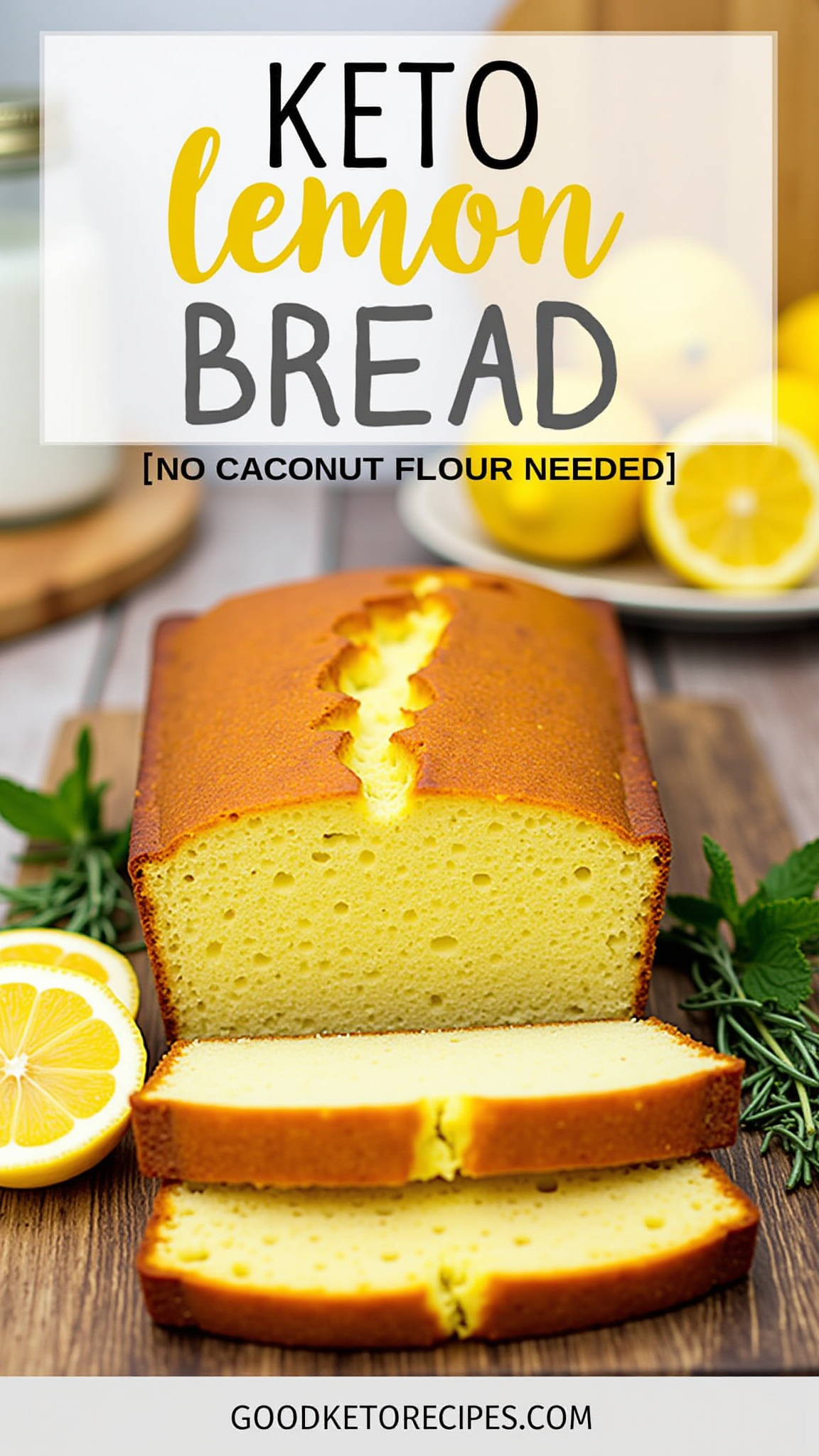
Affiliate Link Disclosure: Some of the links in this post are affiliate links. This means that if you click on the link and make a purchase, I may receive a small commission at no extra cost to you. I only recommend products or services that I personally use and believe will be valuable to my readers.
